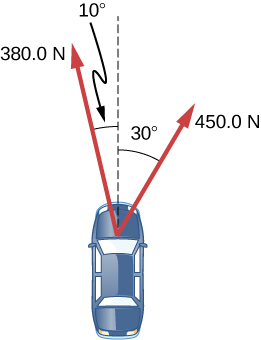| << Chapter < Page | Chapter >> Page > |
Check Your Understanding A car has forces acting on it, as shown below. The mass of the car is 1000.0 kg. The road is slick, so friction can be ignored. (a) What is the net force on the car? (b) What is the acceleration of the car?

a. ; b.
Newton actually stated his second law in terms of momentum: “The instantaneous rate at which a body’s momentum changes is equal to the net force acting on the body.” (“Instantaneous rate” implies that the derivative is involved.) This can be given by the vector equation
This means that Newton’s second law addresses the central question of motion: What causes a change in motion of an object? Momentum was described by Newton as “quantity of motion,” a way of combining both the velocity of an object and its mass. We devote Linear Momentum and Collisions to the study of momentum .
For now, it is sufficient to define momentum as the product of the mass of the object m and its velocity :
Since velocity is a vector, so is momentum.
It is easy to visualize momentum. A train moving at 10 m/s has more momentum than one that moves at 2 m/s. In everyday life, we speak of one sports team as “having momentum” when they score points against the opposing team.
If we substitute [link] into [link] , we obtain
When m is constant, we have
Thus, we see that the momentum form of Newton’s second law reduces to the form given earlier in this section.
Explore the forces at work when pulling a cart or pushing a refrigerator, crate, or person. Create an applied force and see how it makes objects move. Put an object on a ramp and see how it affects its motion.
Why can we neglect forces such as those holding a body together when we apply Newton’s second law?
A rock is thrown straight up. At the top of the trajectory, the velocity is momentarily zero. Does this imply that the force acting on the object is zero? Explain your answer.
No. If the force were zero at this point, then there would be nothing to change the object’s momentary zero velocity. Since we do not observe the object hanging motionless in the air, the force could not be zero.
Andrea, a 63.0-kg sprinter, starts a race with an acceleration of . What is the net external force on her?
If the sprinter from the previous problem accelerates at that rate for 20.00 m and then maintains that velocity for the remainder of a 100.00-m dash, what will her time be for the race?
Running from rest, the sprinter attains a velocity of , at end of acceleration. We find the time for acceleration using , or For maintained velocity, , or . .

Notification Switch
Would you like to follow the 'University physics volume 1' conversation and receive update notifications?